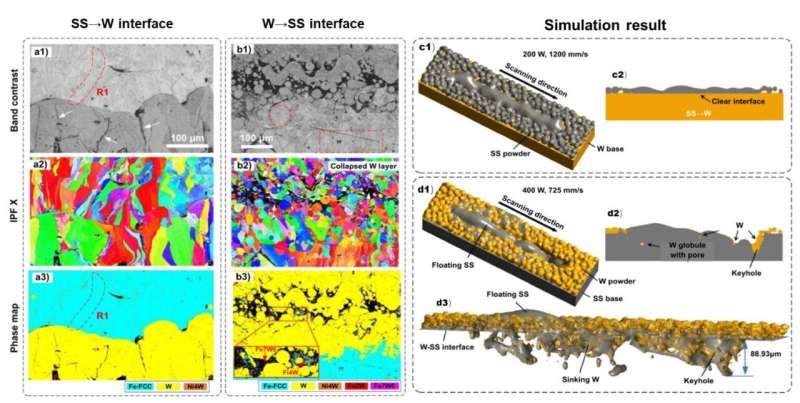Material combination with 2000 C melting temperature difference printed via multi-material laser powder bed fusion

Scientists from the University of Manchester have developed a novel multi-material LPBF method to build tungsten (W) and stainless steel (SS) together and used the modeling method to reveal the bonding mechanism. So far, there have been no previous studies reported on successfully fabricating the 3D printed SS→W→SS multiple material structures and how the physical property differences affect the W and SS interfacial bonding in the laser printing process.
W has excellent sputtering resistance, plasma radiation resistance and low thermal expansion coefficient, but it is very brittle. Additive manufacturing (AM) of W with other metals such as nickel (Ni) and iron (Fe) can reduce the brittleness of W and increase its ductility.
Interestingly, the bonding mechanisms of SS→W and W→SS are totally different. Pre-printed W part was not remelted during the LPBF printing of the SS part. When building the W→SS interface, the high laser energy for melting W caused the top surface of the pre-printed SS to be remelted and recrystallized. Meanwhile, the practically melted W powders sinked into the melted SS.
This research analyzed the bonding mechanism of W and SS in LPBFed SS→W→SS sandwich structure via experimental and simulation methods. AM of W–SS bimetallic components has the potential to be used in the future nuclear industry. The bonding mechanisms provide a new path to design the bonding structure of multiple materials, especially for the materials that have significant physical property differences.
One of the lead researchers, Professor Lin Li commented, " multi-material LPBF provides more design & manufacturing freedom of component. A comprehensive understanding of the bonding mechanisms is essential for extending pure academic studies to actual industrial applications. "
Multiple material additive manufacturing is an emerging research field that can increase the functionality of 3D printed components to be used in many high-value applications and extreme atmospheres. But until now, there has limited research that finds the proper application for multiple material additive manufacturing. The first author Professor Chao Wei said "Our work shows the multi-material LPBF is a powerful tool in building the components for the nuclear industry."
By analyzing the experimental and modeling result, the effect of material density, melting point and thermal property for the bonding of W and SS were understood by the researchers of The University of Manchester. The mechanism of bonding can provide insight into the printing of other dissimilar material combinations via multi-material LPBF.
Dr. Dongxu Cheng said, "The fabrication of W and SS sandwich structure via multi-material LPBF is a milestone achievement for pointing out that multi-material LPBF is the key strategy to achieve the integral manufacturing of end-use components."
The paper is published in the International Journal of Extreme Manufacturing.
More information: Chao Wei et al, Abnormal interfacial bonding mechanisms of multi-material additive-manufactured tungsten–stainless steel sandwich structure, International Journal of Extreme Manufacturing (2022). DOI: 10.1088/2631-7990/ac5f10




















